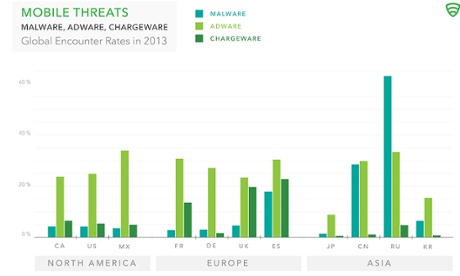
Google’s crackdown on malicious ‘adware’ within Android apps last September had an immediate impact on the number of people encountering this category of mobile malware, according to security firm Lookout.
It has published its latest figures for “encounter rates” with various categories of mobile malware in 2013, noting sharp growth in adware rates between the second and third quarters of the year, but then a decline in many countries in the final quarter.
“In September 2013, Google updated the Play Store terms and conditions, culling around 36,000 apps containing ad networks which broke the rules,” explained Lookout in a blog post.
“Through Q3 2013 Adware began to fall. By late 2013 the biggest offenders, LeadBolt, and RevMob updated their advertising SDKs to be compliant with the new guidelines providing a much less intrusive experience to users.”
The report warns that adware is still frequently encountered by mobile users, with SDKs bundled into apps that steal personal data and insert “occasionally disruptive, often offensive adverts” into the user experience. It also notes that smartphone users are five times more likely to encounter adware than malware.
“In this world where our personal phones are used in the corporate workplace, gaining unprecedented access to valuable information, it is even more important than ever before that we police advertising networks,” claims Lookout.
“Ensuring that they, and the apps that carry them, are built from the ground up with privacy and security in mind is the only way we will prevent criminals from adapting to this latest opportunity.”
Symantec uses a different term – “madware” – to describe adware, and in October 2013 suggested that 55% of all known mobile advertising libraries available to developers were classified in this category.
“In 2012, 15% of apps seen on Google Play included madware, while in 2013 up to the end of June, we have seen that 23.8% of apps contain madware,” explained the company’s Mobile Adware and Malware Analysis report.
Lookout’s new report also notes the rise of another mobile malware category, “chargeware”. This refers to apps – often focused on pornographic content – that are deliberately unclear about how they charge users, and how those people can unsubscribe,
“In 2013, hundreds of thousands of Lookout users encountered apps of this nature (an encounter rate of 13% in France and 20% in the UK),” it explains. According to the report, having chargeware installed on a device more than doubles people’s risk of encountering trojan malware in other apps that they download.

